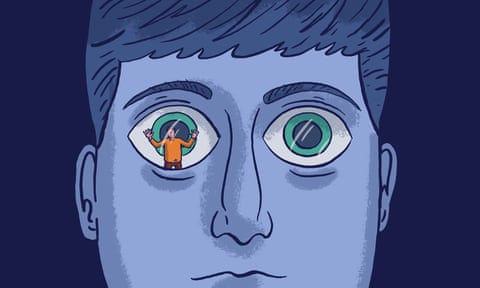Jake Haendel was a hard-partying chef from a sleepy region of Massachusetts. When he was 28, his heroin addiction resulted in catastrophic brain damage and very nearly killed him. In a matter of months, Jake’s existence became reduced to a voice in his head.
Jake’s parents had divorced when he was young. He grew up between their two homes in a couple of small towns just beyond reach of Boston, little more than strip malls, ailing churches and half-empty sports bars. His mother died of breast cancer when he was 19. By then, he had already been selling marijuana and abusing OxyContin, an opioid, for years. “Like a lot of kids at my school, I fell in love with oxy. If I was out to dinner with my family at a restaurant, I would go to the bathroom just to get a fix,” he said. He started culinary school, where he continued to experiment with opioids and cocaine. He hid his drug use from family and friends behind a sociable, fun-loving front. Inside, he felt anxious and empty. “I numbed myself with partying,” he said.
After culinary school, he took a job as a chef at a local country club. At 25, Jake tried heroin for the first time, with a co-worker (narcotics are notoriously prevalent in American kitchens). By the summer of 2013, Jake was struggling to find prescription opioids. For months, he had been fending off the symptoms of opioid withdrawal, which he likened to “a severe case of the flu with an added feeling of impending doom”. Heroin offered a euphoric high, staving off the intense nausea and shaking chills of withdrawal.
Despite his worsening addiction, Jake married his girlfriend, Ellen, in late 2016. Early in their relationship, Ellen had asked him if he was using heroin. He had lied without hesitation, but she soon found out the truth, and within months, the marriage was falling apart. “I was out of control, selling lots of heroin, using even more, spending a ridiculous amount of money on drugs and alcohol,” he said. In May 2017, Ellen noticed that he was talking funnily, his words slurred and off-pitch. “What’s up with your voice?” she asked him repeatedly.
On 21 May, a highway patrol officer stopped Jake on his way to work. He was driving erratically, speeding and swerving between lanes. That morning, he had followed his normal routine, smoking heroin before brushing his teeth. It was also normal for him to smoke, or “freebase” heroin while driving, heating the powder on a piece of foil and inhaling the fumes. “I actually got pretty good at that,” he told me. As the officer approached his car, Jake could feel that something was different in his body. He needed to conceal the baggie of heroin, which lay visible in the open centre console, but he couldn’t reach over and close the compartment. His arms flailed uselessly against the dashboard. The police arrested him for possession of a controlled substance.
Jake made bail, but could hardly walk out of the station. In the next two days, his condition deteriorated and, on 24 May, his wife called an ambulance to their home. He stumbled to the front door, leaning on the walls to support himself. The medical responders thought he might be having a stroke, so he was rushed to hospital. Brain scans showed an unmistakable imaging pattern: profound, bilateral damage to the white matter, the bundles of nerve fibres that facilitate communication between different regions of the brain.
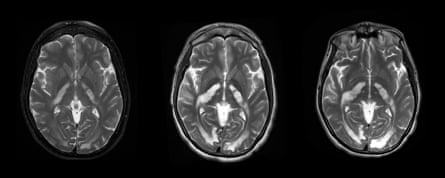
He was diagnosed with toxic progressive leukoencephalopathy, also known as “chasing the dragon syndrome”, usually caused by inhaling the fumes from heroin heated on aluminium foil. An unknown toxin, probably something in the substance that had been added to the heroin to make it go further, was wreaking havoc in Jake’s brain. There was no known cure or treatment, so he was sent home with a store of palliative medications.
Through the summer and autumn, Jake’s symptoms worsened. His muscles grew weak and his limbs became contorted. At home, he fell over frequently and had trouble swallowing. He couldn’t eat solid food and his speech became increasingly unintelligible.
In November, Jake was admitted to hospital and transferred to the neuroscience intensive care unit, where he was put on a ventilator and feeding tube. He suffered autonomic storms – a frightening constellation of symptoms sometimes seen following brain injuries. During a storm, the nervous system is in an overactive, disturbed state. Blood pressure rises, the body sweats profusely and spasms violently, breathing becomes rapid and shallow, and the heart might beat more than 200 times a minute. Jake would storm for four, eight, 12 hours at a time. “It was agonising to watch,” his father, a plainspoken man in his early 60s, told me.
Jake was fighting for his life. He was scared, confused, sometimes hallucinating. Damage to the myelin, the protective sheaths surrounding nerve cells in the brain, progressed until he had no motor control, and could neither speak nor direct his eye movements. For the most part, he understood what was happening, but could not communicate. He could hear comments from nurses and doctors who believed him to be irreversibly brain damaged. Jake recalls an ER doctor observing him like a specimen to be dissected. “Oh, geez, this guy’s so contracted,” the doctor said, hovering inches above Jake’s face. “It put me into more pain just hearing him talk about me like that,” Jake told me. “Like I wasn’t there.”
Eventually, the storms lessened in severity, and he was moved to a nursing home. After a while he was offered palliative care at home, which is generally given to those with terminal illness. His father was told Jake was expected to die within weeks.
To outside observers, Jake exhibited no signs of awareness or cognition. “Is he in there?” his wife and father would ask the doctors. No one knew for sure. An electroencephalogram (EEG) of his brain showed disrupted patterns of neural activity, indicating severe cerebral dysfunction. “Jake was pretty much like a houseplant,” his father told me.
They had no way of knowing Jake was conscious. In medical terms, he was “locked in”: his senses were intact, but he had no way of communicating.
“I could do nothing except listen and I could only see the direct area in front of me, based on how the staff would position me in bed,” Jake later wrote. The disease had attacked the cables carrying information through his brain and into his muscles, but had spared the areas that enable conscious processing, so he was fully alert to the horror of his situation. He struggled to make sense of this new reality, unable to communicate, and terrified at the prospect of this isolation being permanent.
Throughout, Jake maintained a clear sense of himself. He felt every jolt, twinge and spasm of pain. “I couldn’t tell anyone if my mouth was dry, if I was hungry, or if I had an itch that needed to be scratched,” he wrote later.
He was in constant pain, and was afraid of dying – but, worse than that, he feared being trapped in his body for ever.
For months, there was nothing for Jake to do but listen to himself think. His condition mirrored that of French journalist Jean-Dominique Bauby, who published a memoir in 1997 about his experience of locked-in syndrome, written by a transcriber interpreting blinks of Bauby’s left eyelid. The title, The Diving Bell and the Butterfly, conjures the image of his body as a sinking tomb with an oxygen hookup, his mind a fluttering creature trapped inside. In 2007, the book was made into an award-winning film.
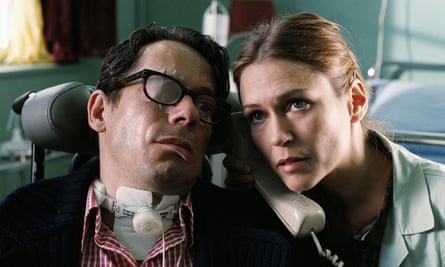
Since that time, medical experts have invented ways of communicating with locked-in patients (including a groundbreaking “brain-reading device”). They’ve also gained a deeper understanding of locked-in patients’ mental states, with studies showing that a surprising number report a positive quality of life. For his part, Bauby struggled to find meaning in such a distressing experience. His memoir is an astonishing portrait of a shipwrecked mind. “Not only was I exiled, paralysed, mute, half deaf, deprived of all pleasures, and reduced to the existence of a jellyfish,” Bauby wrote, “but I was also horrible to behold.”
“I felt disgusting all the time,” Jake told me. He received oxygen and food via tubes, and he was constantly drenched in sweat. His skin, sensitive to minor sensory changes, often burned. The autonomic storms, though less severe, raged on, gripping Jake in distressing spikes of heart rate, high temperatures and feelings of suffocation.
Back at home, Jake’s world shrank to the space of his low-ceilinged room. After a few weeks in bed, he hit on a kind of internal back-and-forth, which became key to his survival. “Two voices, both my own,” as he later described his often-frenzied inner dialogue.
“How are you doing today, Jake?”
“Oh, not bad, just waiting for my medication.”
“Yeah, it’s coming soon. Don’t freak out. You’re OK.”
“I know, I’m trying not to freak out. Oh, God, am I freaking out? What’s going to happen to me?”
“It’s OK, just relax. You’re good.”
Jake’s needs were many and constant. Carers, nurses and Ellen –turned him to avoid painful bedsores, kept him covered with quilts and squeezed pain medication and liquid food through his tube. Though they didn’t know it, Jake had numerous “conversations” with them, too.
“I would interject all the time when people were talking around me. If one nurse asked another, ‘Can he hear me right now?’, I would shout in my head, ‘Yes, I can hear you!’” Jake continued: “I loved when anyone would talk to me, even if they didn’t truly believe I was ‘in there’. One of the aides sang to me. Another said: ‘Jake, you look like a Greek god.’ I admit I did like that.”
More than anyone, Ellen felt certain that he was fully conscious. She had an ability to look into his eyes and understand what he needed. He described her intuitions as “telepathic”. According to Steven Laureys, a Belgian neurologist and expert on locked-in syndrome, “It has been shown that more than half of the time it was the family and not the physician who first realised that the patient was aware.” Medical professionals, however, do caution that family members “see what they wish to see”.
In Jake’s case, the majority of his family and friends– were told very little about his health once he was home. Ellen was highly protective of him, isolating him from potential “bad influences” and insisting that he only occasionally receive visitors.
Jake helplessly witnessed heated arguments in the room where he lay. He could only stare straight ahead as bitter rows about his care echoed throughout the house. Today, Jake and his wife are estranged and no longer communicate, but he still credits her as his lifeline while he was locked in.
A psychologist would later tell Jake that his sustained awareness was a “gift and a curse”. “I wanted so badly to tell everyone what I was thinking,” Jake said. He endured a tremendous amount of guilt that he, a drug addict, had put his family through a nightmarish ordeal, and that the state had to foot an extraordinarily expensive medical bill likely costing millions of dollars.
Besides suffering constant discomfort and shame, his overwhelming sensation was of the hours crawling slowly by. “God dammit, the boredom!” he said. He worked out maths problems in his head and fantasised about being outdoors, playing games, having sex. He counted out 1,000 seconds, over and over again.
In his room at the nursing home, a clock on the wall hung just out of view. “That was like torture,” he told me. Television offered solace, not just as entertainment but also as a means of tracking time. Jake figured out what network cable shows appeared on which nights. “I always wanted to know what time it was, what day it was, how long it had been,” Jake said.
Then there were the early morning prosperity preachers. Most days, Jake would suffer a cold sweat between 5am and 7am. Televangelists often appeared on the local networks around then, when the time slots were cheap. Jake despised their histrionic ramblings, but had no choice but to hear them. “I would have to listen to a religious nut every morning asking for money,” he would later write in a Facebook post. “I felt like I was in hell, like I was already being tortured, and these scam artists were torture on top of torture.”
Jake was very down during this time, “thinking lots of depressing thoughts” and ruminating on the past. “There were days when I would think about my funeral for hours.”
After six months, Jake had lived longer than the state had expected he would, and could no longer receive at-home palliative care. Medical staff still had no idea if he was conscious, but his vital signs were stable enough that he could be moved. He was admitted to Massachusetts general hospital in Boston for re-evaluation in May 2018.
In the days following his readmission, Jake began to feel increasingly hopeful about surviving and even recovering.
In late June, he noticed that he could exert very limited control over his eye gaze, just enough to shift his vision up and down. “I thought to myself: ‘This is new,’” Jake said. Control of eye gaze can be the first stage in recovery of non-verbal communication – but at first it was inconsistent, so although staff noticed the flickers of motion in his eyes, they still couldn’t know for certain if he was consciously directing them. “It was incredibly discouraging to hear from the doctors, over and over, ‘It’s involuntary movement’. There were times when I felt like I was hysterically crying on the inside,” Jake told me.
“Jake showed no emotion in his face,” his father said. “It was hard to imagine he was in there.”
On 4 July 2018, Jake had a breakthrough. That night, from the hospital’s 22nd floor, Jake could hear, but not see, the Independence Day fireworks over the Charles River. “I thought to myself: ‘I’m gonna see those things again,’” he said.
The next day, Jake’s primary care doctor noticed a very slight movement in his right wrist. He darted to the bedside. “Do that again if you can,” his doctor said. “Move your wrist.”
Jake suddenly found that he didn’t have to think about it; his wrist simply moved. The movement was minor, but it was a sign that his body was waking up. His doctors were shocked. The joy Jake felt was “indescribable”.
Within days, he managed to blink in response to questions. After a week, he was transferred to the brain injury unit at the Spaulding rehabilitation hospital across town. Spaulding is an impressive facility in a sleek, modern building, regularly ranked as one of the US’s best hospitals.
In the weeks that followed, Jake underwent a shift in his thinking. He started repeating a string of positive phrases to himself – “You can do this”, “You’re gonna make it”. “I just really wanted to get better,” he said. With effort, he was beginning to move his neck and tongue. “I was so freakin’ excited,” Jake told me. Soon, he achieved a crude system of communication: tongue out for “yes”, blink for “no”.
Michelle Braley, a speech therapist at Spaulding, was surprised to be working with a patient previously considered terminally ill. “When I read his chart, I remember thinking, ‘What’s this guy doing here?’ I had never seen a case as dire who became a candidate for rehab.”
Braley helped Jake learn to communicate non-verbally, starting with a simple letter board. As Jake gained greater control over his gaze, Braley brought him a device called the MegaBee, a tablet that allows patients to use eye movements to pick letters and phrases, which then show up on a screen. Jake cried frequently spelling out those first messages, elated to pose questions that had plagued him for months.
“A…M…I…S…T…I…L…L…G…O…I…N…G…T…O…D…I…E,” he asked Rebecca Glass, a physical therapist at Spaulding, during one early MegaBee session.
She looked up from the MegaBee’s screen. “I don’t know what the future holds,” she said, “but I don’t think so, Jake.”
Around this time, Ellen was still visiting every day. She had always insisted that he was still there, and now Jake could finally express his gratitude.
Once he could communicate, hospital staff could evaluate his progress. “I did a cognitive assessment to see if there was impairment as a result of the leukoencephalopathy,” Braley said. “It was at that point that I realised that Jake knew exactly what was going on.” Again, the staff were stunned. They had suspected he was aware to some degree, but Jake could answer every question – about his condition, about his past – clearly.
How the brain repairs itself following traumatic injury or progressive disease remains mysterious. In recent decades, though, scientists have learned much more about how new neural circuits are formed, and how different areas of the brain are “recruited” to recover lost function.
I asked Seth Herman, a brain injury specialist at Spaulding, how it was possible for someone like Jake to recover. He cited the brain’s ability to transfer functions to different areas. “The brain wants to heal, to change itself and form new neural pathways,” he said. “Repetition is key, and Jake was willing to put in the work.”
A team of physical and occupational therapists spent weeks manipulating Jake’s muscles and using casts to realign his limbs and improve his range of movement. Gains were modest, but significant. The autonomic storms subsided over time. Jake grew stronger.
Jake left Spaulding in September 2018, and continued his rehabilitation at Western Massachusetts hospital. For the next few months, he remained confined to his bed and a wheelchair, but he was moving again, interacting with people and gaining confidence. By spring 2019, after intensive therapy, he was speaking again: first vowel sounds, then simple phrases, like “I love you” and “thank you”, and later full sentences. He made video calls to family and friends who hadn’t known his whereabouts for months, ecstatic at the opportunity to say: “Surprise, I’m alive!”
During Jake’s time at Western Mass, Ellen grew increasingly distant. By the summer, she had stopped visiting. In May 2019, Jake made a last-ditch effort to save the relationship, organising a movie date. A recreational therapist got him into a van and took him to a nearby cinema. Ellen met him there, and the therapist settled the couple into an empty row and left them alone. They saw Breakthrough, a 2019 film about a teenage boy recovering from a coma. They held hands as they watched scenes of disintegration and recovery. They were both emotional leaving the cinema, and agreed to video chat later that night. But he says she didn’t answer his call, and he hasn’t seen her since.
Locked-in syndrome is rare – estimates say there are only a few thousand in the US at any one time. Most sufferers are victims of stroke or traumatic brain injury, and very few regain significant motor function.
Jake is one of few to emerge from a locked-in state, and doctors describe his recovery as “remarkable” and “unique”. Although MRI scans continue to show signs of damage to his brain’s white matter, he has recovered the power of speech, and hopes to walk again soon.
I first met Jake in February this year, at Tewksbury hospital, an ageing, austere facility outside Boston. It was 18 months since he had regained the ability to communicate, and, as he told me via text message, his speech had improved drastically in recent months. I navigated long, sterile hallways to a pink-walled room, in which he sat alone, upright in bed and eager to talk.
Although his limbs remained contracted and stiff, Jake was quite animated, a powerful personality emerging through hazel eyes and a wide, searching face. He and I are in close in age, both in our early 30s. He greeted me with a warm “How’s it goin’, man?”
I was taken aback by his cheerfulness. He is self-conscious about his new laugh – before he got ill, it was deep and loud; now it’s high-pitched and breathy – but he chuckled constantly, even when describing his darkest moments. He spoke in slow, plodding sentences, and swore in the disarming, down-to-earth manner of someone who doesn’t take himself too seriously.
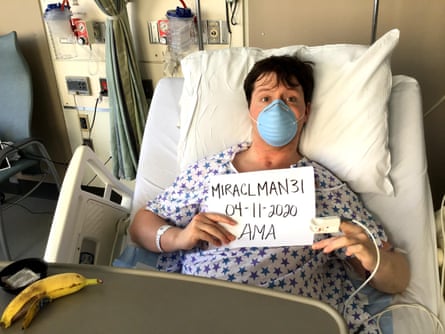
“Wanna see my scar?” He adjusted his shirt to reveal a gaping hole where his feeding tube had been. He told me that when the tube was removed in May 2019, it popped out violently, like a great catharsis. “The doctors say it’s looking good. Might be totally healed in a few years.”
“I used to be so anxious and depressed,” Jake told me. He was propped up by pillows, gesturing grandly with twisted hands. “But, after everything I’ve been through, things just don’t seem so bad.”
Personality changes after brain damage or injury are well established in the medical literature, and Jake is convinced he has changed. “In some ways, he’s still the same old Jakey,” his Aunt Varda told me. “In other ways, he feels like a completely different person. He has such a positive attitude now.”
After meeting Jake, I spoke to his father by phone. He sighed and said that drugs had put his son in a terrible place. In his recovery, though, “He’s become the man I wanted him to be.”
I asked Jake’s uncle, a radiologist, if he had a theory about how Jake got better. “On a superficial level, he got the shit scared out of him and decided he didn’t want to die,” he said. “Neurologically, I have no explanation. Perhaps there’s functioning at the molecular level that we simply can’t detect on an MRI. Maybe it had something to do with who Jake is.”
Jake is adamant that his condition improved because of a mental breakthrough – a shift in his mindset after months of being locked in. “I reached a point where I was like, ‘Fuck this, I’m going to recover.’ I thought about nothing else for weeks,” he told me.
Since the mid-20th century, there has been ongoing debate about the role the mind plays in healing. Jake Haendel – who, for six months, felt like a ghost in a broken machine – remains convinced that he managed to think himself better.
In April, a US army medical taskforce was deployed to Tewksbury hospital to address a sudden spike in coronavirus cases. Hundreds of patients and staff tested positive. More than a dozen died. On 12 April, Jake woke with a high fever, his muscles spasming uncontrollably. The doctors presumed he had Covid-19 and he was rushed to Mass general. “Because of your medical history and weakened autonomic system, there’s a strong chance we’ll have to intubate you,” his doctor told him. Once again, Jake felt like a medical specimen as masked nurses hurried him into a waiting ambulance.
In the pulmonary unit at Mass general, with his oxygen levels dropping, Jake pondered death. He went to sleep that night expecting to be “tubed” in the morning. “I was terrified of going on a ventilator. Being put under and trach’d [having a tracheostomy] was my biggest fear – I wasn’t sure if I could go through it again.”
Jake woke up hungry at sunrise. “Friggin’ starving!” he said. He made a rapid recovery, and was discharged back to Tewksbury in a matter of days.
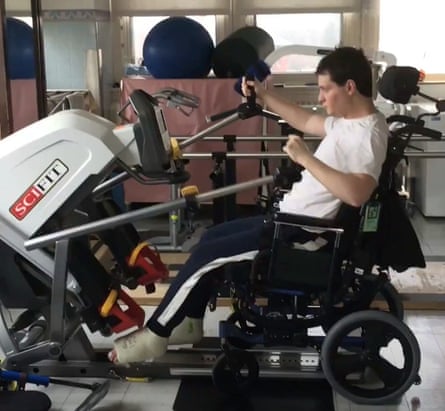
In the following weeks, Jake noticed improvements in his overall condition. The weakness and numbness in his feet had vanished. His knees and legs felt more flexible. Most dramatic were the changes in his voice: his monotone drone evolved into something more expressive, with better inflection and intonation. “Am I crazy, or is my speech way better after having Covid?” he asked Phillip Song, a laryngologist. “This is bizarre, right?”
“Everything about your case is bizarre,” Song told him. The effects of Covid-19 in patients with pre-existing neurological conditions remain poorly understood. In December, Jake will undergo a series of brain scans at Mass general. His doctors there hope to learn more about what impact, if any, Covid might have had on him.
Though Jake isn’t allowed visitors at Tewksbury, where lockdown measures remain in place, he keeps busy, recording videos warning viewers about the disastrous effects of heroin use and offering unique insight into the day-by-day process of recovering from a debilitating brain disease. In a recent video filmed on his 32nd birthday, Jake sits in front of balloons and a Halloween pumpkin, delivering a message of hope: “I know there’s a lot of craziness going on in the world with the Covid pandemic, but I just wanted to say: ‘Stay positive.’ Please be grateful for those you have around you, and what you’ve got.”
“It’s so important to be able to communicate with people,” Jake said to me in February. “It’s the most important thing in the world.” For years, he was shut off from other people, consumed by the physical feelings that drugs brought on. What brings him joy now are moments of connection.
At the end of one of our meetings, Jake asked me a curious hypothetical question. “Would you rather be able to walk without a mind, or think without a body?” Jake spoke in a rush before I could formulate an answer: “I would choose my mind over my body. Even after being locked in, I would still choose my mind.”
